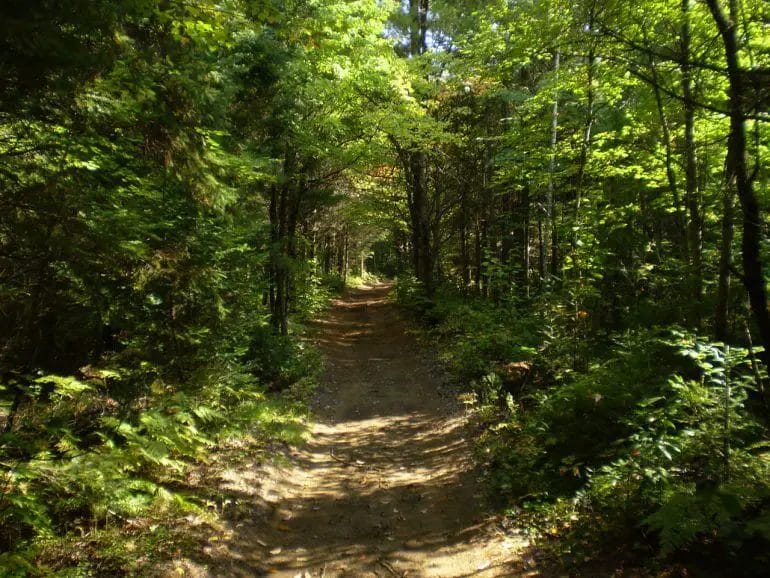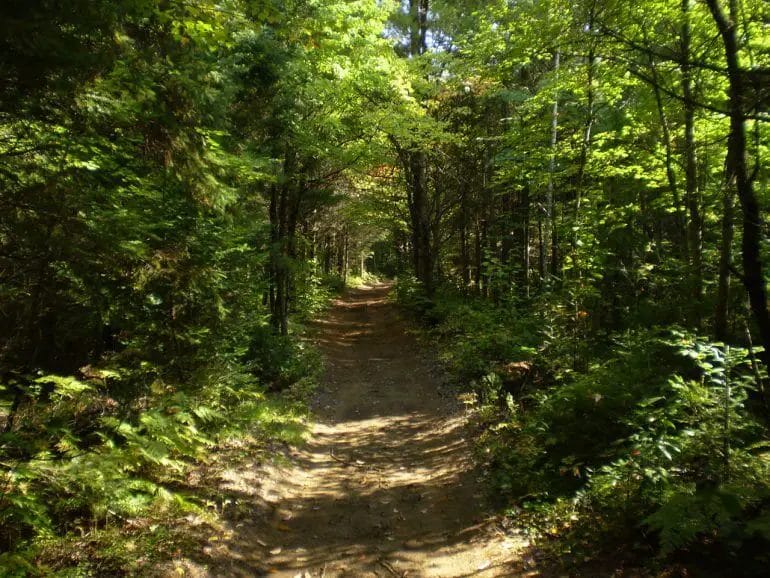Looking to create an exciting and adventurous trail through the woods? Look no further! With our expert guide, you’ll learn how to design and construct a trail that seamlessly blends into the natural environment while providing an exhilarating experience for hikers and outdoor enthusiasts.
From choosing the perfect route to ensuring proper trail drainage, we’ll walk you through every step of the process. Discover tips and techniques for building durable and sustainable trails that promote conservation and minimize environmental impact.

Whether you’re a landowner, a trail enthusiast, or simply someone who wants to share the beauty of nature, our comprehensive guide will equip you with the knowledge and skills to create a stunning trail in the woods. Get ready to embark on a journey of trail-building excellence!

Gathering the Necessary Tools and Supplies
Before starting any project, it is important to gather all the necessary tools and supplies. This will ensure that you have everything you need to complete the task efficiently and effectively. In this section, we will discuss the essential tools and supplies that you may need for various projects.
1. Basic Tools
Every toolbox should have a set of basic tools that can be used for a wide range of projects. Here are some essential tools:
- Hammer: Used for driving nails or removing them
- Screwdriver set: Includes different types of screwdrivers for various screw types
- Pliers: Useful for gripping, bending, and cutting wires or objects
- Tape measure: Used for taking accurate measurements
- Level: Ensures that objects are straight and level
- Utility knife: Great for cutting through materials like cardboard or carpet
2. Power Tools
For more advanced projects, power tools can greatly speed up the process. Here are some commonly used power tools:
- Drill: Useful for making holes or driving screws
- Saw: Comes in various types such as circular saw, jigsaw, or miter saw for cutting different materials
- Power sander: Helps in smoothing surfaces or removing paint
- Router: Used for shaping or hollowing out areas in wood
- Nail gun: Perfect for quickly driving nails into materials
3. Safety Equipment
When working on any project, safety should be a top priority. Here are some essential safety equipment:
- Safety goggles: Protects eyes from flying debris
- Ear protection: Reduces the risk of hearing damage from loud noises
- Dust mask: Prevents inhalation of harmful dust particles
- Gloves: Helps protect hands from cuts, abrasions, or chemicals
- Hard hat: Provides head protection in construction or heavy-duty projects
4. Materials and Supplies
Depending on the nature of your project, you will need to gather specific materials and supplies. Some common ones include:
- Lumber: Used for building structures or furniture
- Screws, nails, and fasteners: Essential for securing materials together
- Paint and brushes: For adding finishes or colors to surfaces
- Adhesives: Such as glue or double-sided tape for joining materials
- Sandpaper: Helps in smoothing surfaces before painting or staining
- Electrical wiring and connectors: Necessary for electrical projects
Remember to carefully plan your project and ensure that you have all the necessary tools and supplies before starting. This will save you time and frustration during the project. Additionally, always follow safety guidelines and wear appropriate protective gear to prevent accidents or injuries.

Clearing the Path and Marking the Trail
When embarking on a journey through unfamiliar terrain, it is essential to have a clear path and clear markers to guide you along the way. The same principle applies to any project or endeavor, whether it be a personal goal or a business endeavor. In this section, we will explore the importance of clearing the path and marking the trail, and how it can contribute to the success of your venture.
In order to move forward and make progress, you need to have a clear path that is free from obstacles and distractions. Just like a hiker who needs to clear away fallen branches and debris along the trail, you need to identify and remove any potential roadblocks that may hinder your progress. This could include anything from outdated processes and systems to unproductive habits or inefficient workflows.
Clearing the path involves taking a step back and assessing your current situation. It requires a critical evaluation of your processes, resources, and strategies. By identifying areas that need improvement or elimination, you can create a clear path that leads to success.
Once you have cleared the path, the next step is to mark the trail. This involves setting clear goals, milestones, and benchmarks that serve as markers to measure your progress. Just like trail markers that guide hikers along the right path, these markers help you stay focused and ensure that you are on track.
When marking the trail, it is important to be specific and measurable. Instead of setting vague goals like “increase sales,” you could set a goal to “increase sales by 10% within the next quarter.” This not only provides a clear target to aim for but also allows you to track your progress and make necessary adjustments along the way.
In addition to setting goals, it is also important to establish a system for tracking and monitoring your progress. This could include regular check-ins, performance metrics, and data analysis. By regularly assessing your progress, you can identify any deviations from the desired path and make necessary course corrections.
Clearing the path and marking the trail is not a one-time task. It is an ongoing process that requires continuous improvement and adaptation. As you move forward, new challenges and obstacles may arise, requiring you to reevaluate your path and adjust your markers accordingly.
In summary, clearing the path and marking the trail are essential steps in any journey towards success. By removing obstacles and distractions and setting clear goals and markers, you can increase your chances of reaching your desired destination. Remember to regularly assess your progress and make necessary adjustments along the way. With a clear path and well-marked trail, you can navigate through any challenges that come your way and achieve your goals.

Adding Features and Enhancements to the Trail
Adding new features and enhancements to a trail can greatly improve the overall user experience and make the trail more engaging and informative. In this section, we will explore various ways to enhance a trail and discuss the benefits of adding new features.
1. Interactive Map
An interactive map is a valuable addition to any trail as it provides users with a visual representation of the trail route and highlights important points of interest. By incorporating a map, users can easily navigate through the trail and get a better understanding of its layout. They can also visualize their progress and see how far they have come.
The interactive map can include markers or pins that indicate specific locations or landmarks along the trail. These markers can be clickable, providing users with additional information or images related to that particular point of interest. This feature not only enhances the trail experience but also educates and engages users.
2. Photo Gallery
A photo gallery is another great feature to add to a trail. It allows users to view and share photos of the trail, capturing its beauty and uniqueness. Users can upload their own photos or browse through a collection of curated images taken by other trail enthusiasts.
With a photo gallery, users can get a glimpse of what to expect before embarking on the trail. It can also serve as a source of inspiration for those who are planning their next outdoor adventure. Additionally, a photo gallery can create a sense of community among trail users, fostering a shared appreciation for nature and the great outdoors.
3. Trail Difficulty Rating
Adding a trail difficulty rating is a useful feature for hikers of all skill levels. This rating system provides an objective assessment of the trail’s difficulty, taking into account factors such as elevation gain, terrain conditions, and overall trail length. It helps hikers determine if the trail is suitable for their fitness level and experience.
The trail difficulty rating can be represented by a scale or symbol, with an accompanying description that details the level of physical exertion and technical skills required. This feature enables hikers to make informed decisions and choose trails that align with their capabilities, ensuring a safe and enjoyable experience.
4. Trail Reviews and Ratings
Incorporating a trail review and rating system allows users to share their experiences and provide feedback on the trail. This user-generated content can be invaluable for future trail enthusiasts who are looking for insights and recommendations.
Trail reviews can cover various aspects such as trail conditions, scenic viewpoints, wildlife sightings, and any notable challenges or highlights. Users can rate the trail based on factors like beauty, difficulty, accessibility, and overall enjoyment. These reviews and ratings add credibility and authenticity to the trail, helping others make informed decisions.
5. Trail Challenges and Achievements
Introducing trail challenges and achievements can add an element of gamification to the trail experience. Users can earn badges or rewards for completing specific tasks or reaching milestones along the trail.
These challenges can vary from simple tasks like spotting a specific bird species or identifying certain plants to more demanding feats like completing the trail within a certain timeframe or conquering challenging sections. By incorporating trail challenges and achievements, the trail becomes more interactive and encourages users to explore and engage with their surroundings.
Summary
Adding features and enhancements to a trail can significantly enhance the user experience and make the trail more enjoyable and informative. Interactive maps, photo galleries, trail difficulty ratings, user reviews and ratings, as well as trail challenges and achievements, are all valuable additions that can attract more users and keep them engaged. By continuously improving and updating the trail with new features, trail managers can ensure that their trails remain relevant and appealing to outdoor enthusiasts.
Maintaining and Upkeeping the Trail for Long-term Use
Once the trail is constructed, it is important to implement a regular maintenance and upkeep plan to ensure its longevity and usability. Proper maintenance not only enhances the trail’s aesthetic appeal but also contributes to the safety and enjoyment of users. In this section, we will discuss some essential practices for maintaining and upkeeping the trail for long-term use.
1. Regular Inspection
Regular inspections are crucial for identifying potential issues and addressing them before they worsen. Inspections should be conducted at least once a month to assess the condition of the trail. During these inspections, the following areas should be examined:
- Trail surface: Check for any signs of erosion, cracks, or potholes. Repair any damaged sections promptly to prevent accidents.
- Drainage systems: Ensure that drainage ditches and culverts are clear of debris and functioning effectively. Poor drainage can lead to water accumulation, which can damage the trail surface.
- Signage and markings: Inspect trail signage, markers, and directional signs to ensure they are visible and legible. Replace any faded or damaged signs.
- Vegetation control: Trim back overgrown vegetation to maintain proper sightlines and prevent encroachment onto the trail.
2. Trail Cleaning
Regular cleaning of the trail is necessary to remove debris and maintain a clean and inviting environment for users. Cleaning activities should include:
- Litter removal: Regularly inspect the trail for any litter and remove it promptly. Encourage users to dispose of their trash properly.
- Vegetation control: Clear any fallen branches, leaves, or other natural debris from the trail surface.
- Invasive species management: Monitor for invasive plant species and implement appropriate measures to control and prevent their spread.
3. Trail Surface Maintenance
The trail surface requires periodic maintenance to ensure a smooth and safe experience for users. Some important surface maintenance practices include:
- Repairing cracks and potholes: Fill in any cracks or potholes on the trail surface to prevent further damage and minimize tripping hazards.
- Resurfacing: Over time, the trail surface may deteriorate and require resurfacing. Plan regular resurfacing projects to maintain the quality of the trail.
- Winter maintenance: If the trail experiences winter conditions, regular snow removal and ice control measures should be implemented to ensure safe passage for users.
4. Bridge and Structure Maintenance
If the trail includes bridges or other structures, they require additional maintenance to ensure their integrity and safety. Key maintenance tasks for bridges and structures include:
- Regular inspections: Conduct regular inspections of bridges and structures to identify any signs of wear, damage, or deterioration.
- Repair and maintenance: Address any identified issues promptly by repairing or replacing damaged components.
- Anti-slip measures: Apply anti-slip coatings or treatments to bridge surfaces to prevent accidents, especially in wet or icy conditions.
5. Community Engagement and Education
Engaging the local community and trail users is essential for creating a sense of ownership and responsibility towards the trail. Some ways to foster community engagement and education include:
- Trail user surveys: Conduct periodic surveys to gather feedback from trail users, identify areas for improvement, and address any concerns.
- Volunteer programs: Organize volunteer programs to involve the community in trail maintenance activities such as cleaning, vegetation control, or minor repairs.
- Educational initiatives: Provide educational resources and information about trail etiquette, safety guidelines, and the importance of preserving the trail’s natural environment.
In summary, maintaining and upkeeping a trail is crucial for its long-term use and enjoyment. Regular inspections, trail cleaning, surface maintenance, bridge and structure maintenance, as well as community engagement and education, are all vital components of an effective trail maintenance plan. By implementing these practices, you can ensure that the trail remains safe, aesthetically pleasing, and accessible to all users for years to come.
FAQs
1. How can I make a trail in the woods?
To make a trail in the woods, start by identifying the desired route and clearing any debris or vegetation along the path. Use a trail building tool, such as a mattock or shovel, to level the ground and remove obstacles. Mark the trail with blazes or signs to ensure visibility. Regular maintenance, like removing fallen branches or repairing erosion, will help keep the trail in good condition.
2. What materials can I use to create a trail?
For creating a trail in the woods, you can use natural materials like wood chips, gravel, or small rocks to provide a stable surface. These materials help with drainage and prevent erosion. Additionally, using fallen logs or stones as steps or bridges can enhance the trail experience and blend with the natural surroundings.
3. Are there any considerations for environmental impact when making a trail in the woods?
When making a trail in the woods, it is important to minimize the environmental impact. Avoid sensitive areas such as wetlands or habitats of rare species. Use sustainable materials and techniques that won’t harm the natural ecosystem. Maintain proper drainage to prevent erosion and consider using natural landscaping methods to minimize disturbance to the surrounding vegetation.
Conclusion
In conclusion, creating a trail in the woods can be an exciting and rewarding experience for outdoor enthusiasts. By following a few simple steps, you can design a trail that harmoniously blends with nature while providing an enjoyable and safe experience for hikers.
Remember to consider the environment and wildlife when planning your trail, ensuring minimal disruption to the ecosystem. Marking the trail with clear signage and maintaining it regularly will help others navigate and preserve its beauty.
Whether you’re a nature lover, a fitness enthusiast, or simply seeking a peaceful escape, building a trail in the woods offers a chance to connect with nature, explore the unknown, and share the beauty of the outdoors with others.